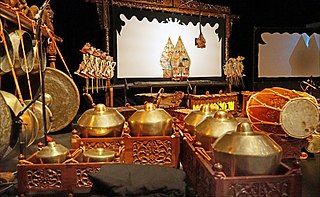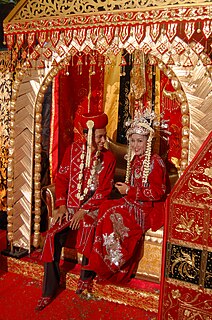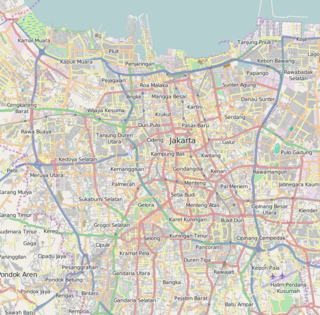Related Research Articles

Jakarta, officially the Special Capital Region of Jakarta, is the capital and largest city of Indonesia. On the northwest coast of the world's most-populous island of Java, it is the centre of economy, culture and politics of Indonesia with a population of 10,770,487 in the city as of 2020. Although Jakarta only covers 699.5 square kilometres (270.1 sq mi), the smallest among any Indonesian provinces, its metropolitan area covers 6,392 square kilometres (2,468 sq mi), and is the world's second-most populous urban area after Tokyo, with a population of about 35.934 million as of 2020. Jakarta's business opportunities, as well as its potential to offer a higher standard of living, have attracted migrants from across the Indonesian archipelago, making it a melting pot of numerous cultures. Jakarta is nicknamed the "Big Durian", the thorny strongly-odored fruit native to the region, seen as the Indonesian equivalent of the "Big Apple".

The music of Indonesia demonstrates its cultural diversity, the local musical creativity, as well as subsequent foreign musical influences that shaped contemporary music scenes of Indonesia. Nearly thousands of Indonesian islands having its own cultural and artistic history and character. This results in hundreds of different forms of music, which often accompanies by dance and theatre.
West Java is a province of Indonesia on the western part of the island of Java, with its provincial capital in Bandung. West Java is bordered by the province of Banten and the country's capital region of Jakarta to the west, the Java Sea to the north, the province of Central Java to the east and the Indian Ocean to the south. The province is the native homeland of the Sundanese people, the second-largest ethnic group in Indonesia after the Javanese.

The erhu, is a two-stringed bowed musical instrument, more specifically a spike fiddle, which may also be called a Southern Fiddle, and sometimes known in the Western world as the Chinese violin or a Chinese two-stringed fiddle.

Cirebon is a port city on the northern coast of the Indonesian island of Java. It is the only coastal city of West Java, located about 40 km west of the provincial border with Central Java, approximately 297 km (185 mi) east of Jakarta, at 6°43′S108°34′E. It had a population of 296,389 at the 2010 Census and 307,319 at the 2015 Census; the latest official estimate is 322,322.

The rebana or terbangan is a Malay tambourine that is used in Islamic devotional music in Southeast Asia, particularly in Indonesia, Malaysia, Brunei, and Singapore. The sound of the rebana often accompany Islamic ritual such as the zikir. The name rebana came from the Arabic word robbana. The rebana is also used by the Cham people of Cambodia and also gave rise to the Rabana which is used by the Sinhalese people of Sri Lanka.

Betawi people, or Betawis, are an Austronesian ethnic group native to the city of Jakarta and its immediate outskirts, as such often described as the native inhabitants of the city. They are the descendants of the people who inhabited Batavia from the 17th century onwards.

Cirebon Regency is a regency (kabupaten) of West Java, Indonesia. Sumber is its capital. The area and population excludes those of Cirebon City, which is an independent administration, although totally surrounded by the regency on its landward side.
Betawi Malay, also known as Jakartan Malay or Batavian Malay, is the spoken language of the Betawi people in Jakarta, Indonesia. It is the native language of perhaps 5 million people; a precise number is difficult to determine due to the vague use of the name.
Jiangnan sizhu is a style of traditional Chinese instrumental music from the Jiangnan region of China.

Setu Babakan Betawi Cultural Village or Setu Babakan is a cultural park of Betawi people, which is located at Srengseng Sawah, Jagakarsa, Jakarta in Indonesia. The village is about 5 kilometers southeast of Ragunan Zoo at the center of the Betawi Cultural Village, a site considered as part of the cultural heritage of Jakarta, which is devoted to the preservation of the indigenous Betawi culture. The location of the Betawi Cultural Village is replacement of the previous Condet (Betawi) Cultural Village which is eroded by the time.

Bir pletok is an Indonesian traditional drink of the Betawi people in Jakarta, Indonesia. Pletok beer is a refreshing drink made from a mixture of several spices, namely ginger, fragrant pandan leaves, and lemongrass.

Ondel-ondel is a large puppet figure featured in Betawi folk performance of Jakarta, Indonesia. Ondel-ondel is an icon of Jakarta. Ondel-ondel are utilized for livening up festivals or for welcoming guests of honor, usually in pairs. Ondel-ondel is one of a few Indonesian folk performances that has survived modernization and is still being regularly performed.
Si Ronda is a 1930 silent film from the Dutch East Indies which was directed by Lie Tek Swie and starred Bachtiar Effendi. Based on contemporary Betawi oral tradition, it follows the exploits of a bandit, skilled in silat, known as Si Ronda. In the lenong stories from which the film was derived, Ronda was often depicted as a Robin Hood type of figure. The production, now thought lost, was one of a series of martial arts films released between 1929 and 1931. Si Ronda received little coverage in the media upon its release. A second adaptation of the tale, Si Ronda Macan Betawi, was made in 1978.

Lenong is a traditional theatrical form of the Betawi people in Jakarta, Indonesia.

Betawi cuisine is rich, diverse and eclectic, in part because the Betawi people that create them were composed from numbers of regional immigrants that came from various places in the archipelago, as well as Chinese, Indian, Arab, and European traders, visitors and immigrants that were attracted to the port city of Batavia since centuries ago.

The following outline is provided as an overview of and topical guide to Jakarta:

Roti gambang or ganjel rel is an Indonesian rectangular-shaped brown bread with sesame seeds, flavoured with cinnamon and palm sugar.

Tanjidor is a traditional Betawi musical ensemble developed in Jakarta, Indonesia. This musical ensamble took form of a modest orchestra, and was developed in the 19th century, pioneered by Augustijn Michiels or better known as Major Jantje in the Citrap or Citeureup area on the outskirt of Batavia.
References
- ↑ (in Indonesian) Nurhayati E, Suherman Y, Suryana A, Laelasari E. 2013. Seni Budaya untuk Sekolah Menengah Kejuruan. Bandung: Grafindo Media Pratama.
- 1 2 (in Indonesian) Adi W. 2010. Batavia, 1970: Menyisir Jejak Betawi. Jakarta: Gramedia Pustaka Utama.
- ↑ (in Indonesian) Kusuma, Joel, Wijaya J. 2009. Analisis perbandingan er hu dengan sukong, tehyan dan konghayan. [thesis]. Jakarta: Bina Nusantara University.
- ↑ Studymode. 2011. Erhu [terhubung berkala]. http://www.studymode.com/essays/Erhu-698294.html [27 Apr 2014].